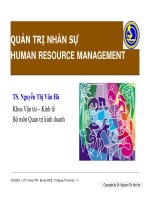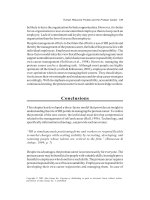Lession 03 Project Human Resource Management
Bạn đang xem bản rút gọn của tài liệu. Xem và tải ngay bản đầy đủ của tài liệu tại đây (997.69 KB, 75 trang )
Lession 3:
Project Human Resource
Management
2
Learning Objectives
Explain the importance of good human resource
management on projects, including the current state
and future implications of human resource
management, especially on information technology
projects.
Define project human resource management and
understand its processes.
Summarize key concepts for managing people and
how people and teams can become more effective.
3
Learning Objectives
Discuss human resource planning and be able to create a project
organizational chart, responsibility assignment matrix, and resource
histogram.
Understand important issues involved in project staff acquisition
and explain the concepts of resource assignments, resource loading,
and resource leveling.
Assist in team development with training, team-building activities,
and reward systems.
Explain and apply several tools and techniques to help manage a
project team and summarize general advice on managing teams.
Describe how project management software can assist in project
human resource management.
4
Learning Objectives
Understand the importance of good communications in
projects.
Explain the elements of project communications planning,
including how to create a communications management
plan and perform a stakeholder communications analysis.
Describe various methods for distributing project
information and the advantages and disadvantages of each,
discuss the importance of addressing individual
communication needs, and calculate the number of
communications channels in a project.
5
Learning Objectives (cont’d)
Understand how the main outputs of performance reporting help
stakeholders stay informed about project resources.
Recognize the importance of good communications
management for stakeholder relationships and for resolving
issues.
List various methods for improving project communications,
such as managing conflicts, running effective meetings, using e-
mail and other technologies effectively, and using templates.
Describe how software can enhance project communications
management.
6
What is Project Human Resource
Management?
Making the most effective use of the people involved with a
project.
Processes include:
Human resource planning: Identifying and documenting project
roles, responsibilities, and reporting relationships.
Acquiring the project team: Getting the needed personnel
assigned to and working on the project.
Developing the project team: Building individual and group
skills to enhance project performance.
Managing the project team: Tracking team member performance,
motivating team members, providing timely feedback, resolving
issues and conflicts, and coordinating changes to help enhance
project performance.
7
Keys to Managing People
Psychologists and management theorists have devoted
much research and thought to the field of managing
people at work.
Important areas related to project management include:
Motivation theories
Influence and power
Effectiveness
8
Intrinsic and Extrinsic Motivation
Intrinsic motivation causes people to participate in an
activity for their own enjoyment.
Extrinsic motivation causes people to do something
for a reward or to avoid a penalty.
For example, some children take piano lessons for
intrinsic motivation (they enjoy it) while others take
them for extrinsic motivation (to get a reward or avoid
punishment).
9
Ways to Have Influence on Projects
1. Authority: The legitimate hierarchical right to issue
orders.
2. Assignment: The project manager's perceived ability to
influence a worker's later work assignments.
3. Budget: The project manager's perceived ability to
authorize others' use of discretionary funds.
4. Promotion: The ability to improve a worker's position.
5. Money: The ability to increase a worker's pay and
benefits.
10
Ways to Have Influence on Projects
(cont’d)
6. Penalty: The project manager's ability to cause
punishment.
7. Work challenge: The ability to assign work that
capitalizes on a worker's enjoyment of doing a
particular task.
8. Expertise: The project manager's perceived special
knowledge that others deem important.
9. Friendship: The ability to establish friendly personal
relationships between the project manager and others.
11
Ways to Influence that Help and
Hurt Projects
Projects are more likely to succeed when project managers
influence people using:
Expertise
Work challenge
Projects are more likely to fail when project managers rely
too heavily on:
Authority
Money
Penalty
12
Power
Power is the potential ability to influence behavior to
get people to do things they would not otherwise do.
Types of power include:
Coercive power
Legitimate power
Expert power
Reward power
Referent power
13
Improving Effectiveness:
Project managers can apply Covey’s seven habits to
improve effectiveness on projects.
Be proactive.
Begin with the end in mind.
Put first things first.
Think win/win.
Seek first to understand, then to be understood.
Synergize.
Sharpen the saw.
14
Organizational Planning
Involves identifying and documenting project
roles, responsibilities, and reporting
relationships.
Outputs include:
Project organizational charts
Staffing management plans
Responsibility assignment matrixes
Resource histograms
15
Sample Organizational Chart for a Large
IT Project
16
Responsibility Assignment Matrixes
A responsibility assignment matrix (RAM) is a
matrix that maps the work of the project, as described
in the WBS, to the people responsible for performing
the work, as described in the OBS.
Can be created in different ways to meet unique project
needs.
17
Sample Responsibility Assignment
Matrix (RAM)
18
RAM Showing Stakeholder Roles
19
. Sample RACI Chart
R = Responsibility, only one R per task
A = Accountability
C = Consultation
I = Informed
20
Acquiring the Project Team
Acquiring qualified people for teams is crucial.
The project manager who is the smartest person on the
team has done a poor job of recruiting!
Staffing plans and good hiring procedures are important,
as are incentives for recruiting and retention.
Some companies give their employees one dollar for
every hour that a new person who they helped hire works.
Some organizations allow people to work from home as
an incentive.
21
Why People Leave Their Jobs
They feel they do not make a difference.
They do not get proper recognition.
They are not learning anything new or growing as a
person.
They do not like their coworkers.
They want to earn more money.
22
Resource Loading
Resource loading refers to the amount of individual
resources an existing schedule requires during specific
time periods.
Helps project managers develop a general
understanding of the demands a project will make on
the organization’s resources and individual people’s
schedules.
Overallocation means more resources than are
available are assigned to perform work at a given time.
23
. Sample Histogram Showing an
Overallocated Individual
What’s wrong with this picture? Assume 100 percent means Joe is
working eight hours per day.
24
Resource Leveling
Resource leveling is a technique for resolving resource
conflicts by delaying tasks.
The main purpose of resource leveling is to create a
smoother distribution of resource use and reduce
overallocation.
25
Resource Leveling Example









